Mendelian inheritance
This article needs attention from an expert in biology. The specific problem is: Does not have an adequate section/referral to a page citing published research that contradicts Mendelian inheritance theory. (October 2023) |
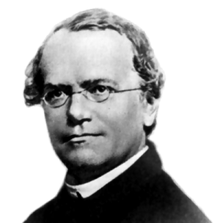
| Part of a series on |
| Genetics |
|---|
 |
Mendelian inheritance (also known as Mendelism) is a type of biological inheritance following the principles originally proposed by Gregor Mendel in 1865 and 1866, re-discovered in 1900 by Hugo de Vries and Carl Correns, and later popularized by William Bateson.[1] These principles were initially controversial. When Mendel's theories were integrated with the Boveri–Sutton chromosome theory of inheritance by Thomas Hunt Morgan in 1915, they became the core of classical genetics. Ronald Fisher combined these ideas with the theory of natural selection in his 1930 book The Genetical Theory of Natural Selection, putting evolution onto a mathematical footing and forming the basis for population genetics within the modern evolutionary synthesis.[2]
History
The principles of Mendelian inheritance were named for and first derived by
Mendel's results were at first largely ignored. Although they were not completely unknown to biologists of the time, they were not seen as generally applicable, even by Mendel himself, who thought they only applied to certain categories of species or traits. A major roadblock to understanding their significance was the importance attached by 19th-century biologists to the apparent blending of many inherited traits in the overall appearance of the progeny,[citation needed] now known to be due to multi-gene interactions, in contrast to the organ-specific binary characters studied by Mendel.[4] In 1900, however, his work was "re-discovered" by three European scientists, Hugo de Vries, Carl Correns, and Erich von Tschermak. The exact nature of the "re-discovery" has been debated: De Vries published first on the subject, mentioning Mendel in a footnote, while Correns pointed out Mendel's priority after having read De Vries' paper and realizing that he himself did not have priority. De Vries may not have acknowledged truthfully how much of his knowledge of the laws came from his own work and how much came only after reading Mendel's paper. Later scholars have accused Von Tschermak of not truly understanding the results at all.[9][10]
Regardless, the "re-discovery" made Mendelism an important but controversial theory. Its most vigorous promoter in Europe was William Bateson, who coined the terms "genetics" and "allele" to describe many of its tenets.[11] The model of heredity was contested by other biologists because it implied that heredity was discontinuous, in opposition to the apparently continuous variation observable for many traits.[12] Many biologists also dismissed the theory because they were not sure it would apply to all species. However, later work by biologists and statisticians such as Ronald Fisher showed that if multiple Mendelian factors were involved in the expression of an individual trait, they could produce the diverse results observed, thus demonstrating that Mendelian genetics is compatible with natural selection.[13][14] Thomas Hunt Morgan and his assistants later integrated Mendel's theoretical model with the chromosome theory of inheritance, in which the chromosomes of cells were thought to hold the actual hereditary material, and created what is now known as classical genetics, a highly successful foundation which eventually cemented Mendel's place in history.[3][11]
Mendel's findings allowed scientists such as Fisher and
Inheritance tools
Punnett Squares
Punnett Squares are a well known genetics tool that was created by an English geneticist, Reginald Punnett, which can visually demonstrate all the possible genotypes that an offspring can receive, given the genotypes of their parents.[16][17][18] Each parent carries two alleles, which can be shown on the top and the side of the chart, and each contribute one of them towards reproduction at a time. Each of the squares in the middle demonstrates the number of times each pairing of parental alleles could combine to make potential offspring. Using probabilities, one can then determine which genotypes the parents can create, and at what frequencies they can be created.[16][18]
For example, if two parents both have a heterozygous genotype, then there would be a 50% chance for their offspring to have the same genotype, and a 50% chance they would have a homozygous genotype. Since they could possible contribute two identical alleles, the 50% would be chopped in half at 25% to account for each type of homozygote, whether this was a homozygous dominant genotype, or a homozygous recessive genotype.[16][17][18]
Pedigrees
Pedigrees are visual tree like representations that demonstrate exactly how alleles are being passed from past generations to future ones.[19] They also provide a diagram displaying each individual that carries a desired allele, and exactly which side of inheritance it was received from, whether it was from their mother's side or their father's side.[19] Pedigrees can also be used to aid researchers in determining the inheritance pattern for the desired allele, because they share information such as the gender of all individuals, the phenotype, a predicted genotype, the potential sources for the alleles, and also based its history, how it could continue to spread in the future generations to come. By using pedigrees, scientists have been able to find ways to control the flow of alleles over time, so that alleles that act problematic can be resolved upon discovery.[20]
Mendel's genetic discoveries
Five parts of Mendel's discoveries were an important divergence from the common theories at the time and were the prerequisite for the establishment of his rules.
- Characters are unitary, that is, they are discrete e.g.: purple vs. white, tall vs. dwarf. There is no medium-sized plant or light purple flower.
- Genetic characteristics have alternate forms, each inherited from one of two parents. Today these are called alleles.
- One allele is dominant over the other. The phenotype reflects the dominant allele.
- Gametes are created by random segregation. Heterozygotic individuals produce gametes with an equal frequency of the two alleles.
- Different traits have independent assortment. In modern terms, genes are unlinked.
According to customary terminology, the principles of inheritance discovered by Gregor Mendel are here referred to as Mendelian laws, although today's geneticists also speak of Mendelian rules or Mendelian principles,[21][22] as there are many exceptions summarized under the collective term Non-Mendelian inheritance. The laws were initially formulated by the geneticist Thomas Hunt Morgan in 1916.[23]
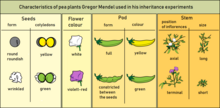
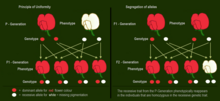

Mendel selected for the experiment the following characters of pea plants:
- Form of the ripe seeds (round or roundish, surface shallow or wrinkled)
- Colour of the seed–coat(white, gray, or brown, with or without violet spotting)
- Colour of the seeds and cotyledons (yellow or green)
- Flower colour (white or violet-red)
- Form of the ripe pods (simply inflated, not contracted, or constricted between the seeds and wrinkled)
- Colour of the unripe pods (yellow or green)
- Position of the flowers (axial or terminal)
- Length of the stem [26]
When he crossed purebred white flower and purple flower pea plants (the parental or P generation) by
He then conceived the idea of heredity units, which he called hereditary "factors". Mendel found that there are alternative forms of factors—now called
Mendel hypothesized that allele pairs separate randomly, or segregate, from each other during the production of the
The
| Law | Definition |
|---|---|
| Law of dominance and uniformity | Some alleles are dominant while others are recessive; an organism with at least one dominant allele will display the effect of the dominant allele.[27] |
| Law of segregation | During gamete formation, the alleles for each gene segregate from each other so that each gamete carries only one allele for each gene. |
| Law of independent assortment | Genes of different traits can segregate independently during the formation of gametes. |
Law of Dominance and Uniformity
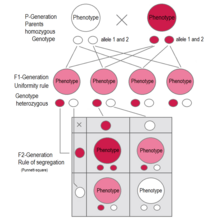
If two parents are mated with each other who differ in one
The principle of dominant inheritance discovered by Mendel states that in a heterozygote the dominant allele will cause the recessive allele to be "masked": that is, not expressed in the phenotype. Only if an individual is homozygous with respect to the recessive allele will the recessive trait be expressed. Therefore, a cross between a homozygous dominant and a homozygous recessive organism yields a heterozygous organism whose phenotype displays only the dominant trait.
The F1 offspring of Mendel's pea crosses always looked like one of the two parental varieties. In this situation of "complete dominance", the dominant allele had the same phenotypic effect whether present in one or two copies.
But for some characteristics, the F1 hybrids have an appearance in between the phenotypes of the two parental varieties. A cross between two four o'clock (Mirabilis jalapa) plants shows an exception to Mendel's principle, called incomplete dominance. Flowers of heterozygous plants have a phenotype somewhere between the two homozygous genotypes. In cases of intermediate inheritance (incomplete dominance) in the F1-generation Mendel's principle of uniformity in genotype and phenotype applies as well. Research about intermediate inheritance was done by other scientists. The first was Carl Correns with his studies about Mirabilis jalapa.[28][31][32][33][34]
Law of Segregation of genes
The Law of Segregation of genes applies when two individuals, both heterozygous for a certain trait are crossed, for example, hybrids of the F1-generation. The offspring in the F2-generation differ in genotype and phenotype so that the characteristics of the grandparents (P-generation) regularly occur again. In a dominant-recessive inheritance, an average of 25% are homozygous with the dominant trait, 50% are heterozygous showing the dominant trait in the phenotype (
In the pea plant example, the capital "B" represents the dominant allele for purple blossom and lowercase "b" represents the recessive allele for white blossom. The pistil plant and the pollen plant are both F1-hybrids with genotype "B b". Each has one allele for purple and one allele for white. In the offspring, in the F2-plants in the Punnett-square, three combinations are possible. The genotypic ratio is 1 BB : 2 Bb : 1 bb. But the phenotypic ratio of plants with purple blossoms to those with white blossoms is 3 : 1 due to the dominance of the allele for purple. Plants with homozygous "b b" are white flowered like one of the grandparents in the P-generation.
In cases of
In some literature sources, the principle of segregation is cited as the "first law". Nevertheless, Mendel did his crossing experiments with heterozygous plants after obtaining these hybrids by crossing two purebred plants, discovering the principle of dominance and uniformity first.[35][27]
Molecular proof of segregation of genes was subsequently found through observation of
Law of Independent Assortment
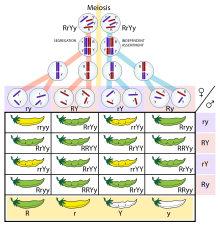

The Law of Independent Assortment proposes alleles for separate traits are passed independently of one another.[38][35] That is, the biological selection of an allele for one trait has nothing to do with the selection of an allele for any other trait. Mendel found support for this law in his dihybrid cross experiments. In his monohybrid crosses, an idealized 3:1 ratio between dominant and recessive phenotypes resulted. In dihybrid crosses, however, he found a 9:3:3:1 ratios. This shows that each of the two alleles is inherited independently from the other, with a 3:1 phenotypic ratio for each.
Independent assortment occurs in
There are many deviations from the principle of independent assortment due to genetic linkage.
Of the 46 chromosomes in a normal
In independent assortment, the chromosomes that result are randomly sorted from all possible maternal and paternal chromosomes. Because zygotes end up with a mix instead of a pre-defined "set" from either parent, chromosomes are therefore considered assorted independently. As such, the zygote can end up with any combination of paternal or maternal chromosomes. For human gametes, with 23 chromosomes, the number of possibilities is 223 or 8,388,608 possible combinations.[39] This contributes to the genetic variability of progeny. Generally, the recombination of genes has important implications for many evolutionary processes.[40][41][42]
Mendelian trait
A Mendelian trait is one whose inheritance follows Mendel's principles—namely, the trait depends only on a single locus, whose alleles are either dominant or recessive.
Many traits are inherited in a non-Mendelian fashion.[43]
Non-Mendelian inheritance
Mendel himself warned that care was needed in extrapolating his patterns to other organisms or traits. Indeed, many organisms have traits whose inheritance works differently from the principles he described; these traits are called non-Mendelian.[44][45]
For example, Mendel focused on traits whose genes have only two alleles, such as "A" and "a". However, many genes have
See also
- List of Mendelian traits in humans
- Simple Mendelian genetics in humans
- Mendelian diseases(monogenic disease)
- Mendelian error
- Particulate inheritance
- Punnett square
References
- ISBN 978-1-108-00613-2
- ISBN 978-0-19-929116-8.
- ^ PMID 11353700.
- ^ ISBN 978-0-395-97765-1.
- ^ Mendel, Gregor; Mendel, Gregor (1866). Versuche über Pflanzen-Hybriden. Brünn: Im Verlage des Vereines.
- ^ "Mendel's Paper (English - Annotated)". www.mendelweb.org. Retrieved 23 March 2024.
- )
- ISSN 1868-6249.
- .
- ISBN 978-80-87378-67-0.)
{{cite book}}: CS1 maint: date and year (link - ^ PMID 14942726.
- JSTOR 14824.
- ^ ISBN 978-0-19-850440-5.
- S2CID 181213898.
- ^ "Gregor Mendel and the Principles of Inheritance | Learn Science at Scitable". www.nature.com. Retrieved 23 March 2024.
- ^ a b c "Basic Principles of Genetics: Probability of Inheritance". www.palomar.edu. Retrieved 23 March 2024.
- ^ PMID 11610096.
- ^ PMID 22326091.
- ^ a b Miller, Christine (1 September 2020). "5.13 Mendelian Inheritance".
{{cite journal}}: Cite journal requires|journal=(help) - PMID 34553796.
- ^ Science Learning Hub: Mendel's principles of inheritance
- ^ Noel Clarke: Mendelian Genetics - An overview
- .
- ^ Gregor Mendel: Versuche über Pflanzenhybriden Verhandlungen des Naturforschenden Vereines in Brünn. Bd. IV. 1866, page 8
- ^ Write Work: Mendel's Impact
- ^ Gregor Mendel: Experiments in Plant Hybridization 1965, page 5
- ^ a b Rutgers: Mendelian Principles
- ^ a b Biology University of Hamburg: Mendelian Genetics
- ISBN 3-8274-1352-4, page 302–303.
- ISBN 3-464-04279-0, page 170 - 171.
- ^ Biologie Schule - kompaktes Wissen: Uniformitätsregel (1. Mendelsche Regel)
- ^ Frustfrei Lernen: Uniformitätsregel (1. Mendelsche Regel)
- ^ Spektrum Biologie: Unvollständige Dominanz
- ^ Spektrum Biologie: Intermediärer Erbgang
- ^ ISBN 3-8274-1352-4
- ^ a b Bailey, Regina (5 November 2015). "Mendel's Law of Segregation". about education. About.com. Retrieved 2 February 2016.
- ^ Spectrum Dictionary of Biology Mendel Rules
- ^ Bailey, Regina. "Independent Assortment". Thoughtco. About.com. Retrieved 24 February 2016.
- ^ Perez, Nancy. "Meiosis". Retrieved 15 February 2007.
- PMID 29109232.
- PMID 27798297.
- PMID 29355539.
- ^ "Genetic Disorders". National Human Genome Research Institute. 18 May 2018.
- PMID 27344551.
- ^ Khan Academy: Variations on Mendel's laws (overview)
Notes
- Bowler, Peter J. (1989). The Mendelian Revolution: The Emergence of Hereditarian Concepts in Modern Science and Society. Johns Hopkins University Press.
- Atics, Jean. Genetics: The life of DNA. ANDRNA press.
- Reece, Jane B.; Campbell, Neil A. (2011). Mendel and the Gene Idea (9th ed.). Benjamin Cummings / Pearson Education. p. 265.
{{cite book}}:|work=ignored (help)
